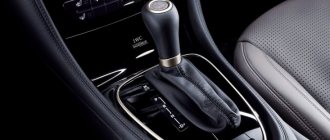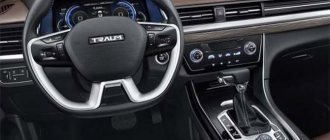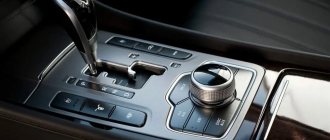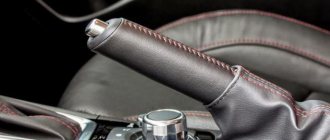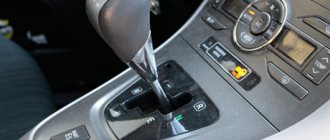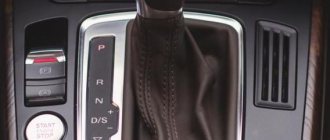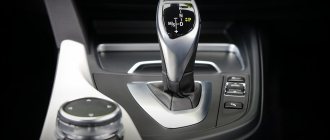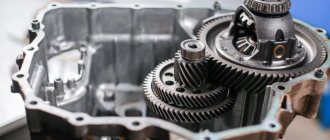In our article, we will look at the design and operating principle of an automatic transmission, list the main types of automatic transmissions, get acquainted with the operating modes, and analyze the advantages and disadvantages of automatic transmissions.
How to drive an automatic - features of cars with automatic transmission
In an automatic transmission, gear shifting is carried out only depending on the speed. When a certain threshold is reached, a transition occurs from one stage to another. This is accomplished thanks to built-in electronics and gear pairs controlled by solenoids. There is also a clutch that ensures a smooth transition from one stage to another.
As practice shows, driving an automatic is much easier than driving a car with a manual transmission. Everything is explained by the operating principle of the automatic transmission and the absence of a third clutch pedal. It is important to remember one thing: every time at the beginning of a standing start, you should press the gas pedal smoothly.
Features of a car with automatic transmission include:
- simplicity and ease of operation of the machine;
- no need to change gears yourself;
- Modern automatic transmissions have no shorter service life than mechanical ones.
Comparison of automatic transmission with manual transmission
In the modern world, “mechanics” are slowly but surely losing ground to their more progressive counterpart - automatic transmission. Automatic transmissions provide smoother and more economical engine operation and smoother running of the machine.
The driver is not required to constantly monitor the speed and engine speed in order to engage the desired gear in time. The automatic will do everything for him, which is especially convenient when driving around the city, and extremely convenient if you are in a traffic jam.
The driver does not need to devote the lion's share of his attention to driving the car. Although there are drivers who like a manual transmission, which allows them to enjoy the continuous physical process of driving the car and complete control of the ride.
Pros and cons of automatic transmission
An automatic transmission has its advantages and disadvantages, which you need to know before buying a car with an automatic transmission or switching from a manual transmission to an automatic transmission.
Pros of automatic transmission
- Simplicity and ease of control, as there is no need to manually switch speeds. The driver only controls the steering wheel and presses the gas and brake.
- The third pedal, the clutch, is missing.
- It's easier to get moving in a car with an automatic transmission.
- Smooth gear shifting and high efficiency.
- High reliability of modern automatic transmissions.
- Inability to “burn out” the clutch and no need to periodically replace the clutch.
Disadvantages of automatic transmission
- Manual transmissions are more economical than automatic transmissions. A car with an automatic transmission consumes about 10-15% more fuel. Although the gradual improvement of machines leads to a decrease in this indicator.
- Automatic transmissions are much more expensive than manual transmissions to maintain and repair. If the machine breaks down and needs to be completely replaced, it will cost a significant amount (up to a third of the cost of a used car).
- The impossibility of rapid acceleration and a sharp increase in speed, which is especially felt when overtaking at a limited distance or in dense oncoming traffic, that is, when you need to overtake very quickly. This problem is partially solved by turning on the sports mode.
- The automatic limits the individual driving experience, unlike manual cars where the driver has complete control over the ride.
- Inability to push start the car.
- The machine can quickly fail if used incorrectly.
- An automatic car has towing limitations, and these are things you need to know before towing another car or trailer.
Basic operating modes of automatic transmission
In cars with automatic transmission, there is no need to change gears. This transmission is equipped with an operating mode switch that determines at what point the transition from one stage to another will occur. The automatic transmission is controlled by buttons and a lever. In this regard, the transmission, on the contrary, is somewhat complicated, because in a manual car there is only a lever and a pedal. Despite the increased number of controls, the control process is much simpler. It is important to know that such a transmission has primary and secondary operating modes. The first include:
- “P” - this Latin letter indicates the activation of the parking mode. The drive wheels are locked and the engine is disconnected from the transmission. It is in this position of the lever that the motor should be started, since there is no load on its shaft.
- “R” - the position of the transmission lever in this mode indicates that reverse gear is engaged. It is activated electronically and only when the machine is completely stopped.
- “N” - if you plan to tow a car, then you need to do it in this mode. The motor is disconnected from the transmission and the drive wheels are not locked.
- “D” - this position of the lever indicates forward movement. It should be turned on whenever you travel.
- “M” - this sign on the automatic transmission indicates that the automatic transmission’s gears are shifted manually, but it is not available on all car models with similar gearboxes.
Additional automatic transmission operating modes
To properly use an automatic transmission, you need to learn additional operating modes. They are also called submodes. Perhaps not all modifications of the boxes will be marked exactly as will be described later in the article:
- Overdrive mode is designated “D” or “O/D”. It is designed for long periods of driving at high speeds. Used outside the city.
- The letters “D3” or “O/D OFF” indicate turning off the overdrive mode. It forcibly disables the 4th stage so that it does not operate during a short-term increase in speed. Allows you to save the life of the torque converter clutch when driving around the city.
- The position of the lever at the “S” or “2” marks indicates the activation of the reduced speed mode. It should be turned on if you plan to drive slowly for a long time. It is used for confident movement on icy roads. In some car modifications, the position is marked with the letter “W”.
- The position of the lever at the “L” or 1 mark means that only the first stage is turned on. It is used in transmission diagnostic or repair mode. You can also turn it on to start on uneven surfaces and then move at creeping speed.
Modes of modern cars
In modern automatic transmissions, to improve vehicle traffic safety, an additional emergency mode has been introduced. It is often not marked in any way, but the system automatically switches to it if a problem is detected in the stage control mechanisms or components. The driver learns about its activation by the corresponding pictogram on the dashboard. In this position, it is possible to drive at a minimum speed, which should be enough to get to the car service center.
Also in modern boxes there are the following operating modes:
- d overdrive;
- Kick down;
- Pwr sport;
- Snow.
Od overdrive _
Learning to drive a car with an automatic transmission includes the use of the O/D overdrive mode. It was already mentioned earlier in the article, but it’s worth remembering. It is needed to block the 4th stage when driving with a short increase in speed. Forced disconnection of the torque converter clutch of this transmission saves its resource. The mode is activated by pressing or releasing a button located directly on or near the lever. The shield usually has a yellow warning indicator.
It should be turned on when driving in traffic at a speed of 40-60 km/h and frequently pressing the brake pedal. If you turn it off, the car will become noticeably slower, since getting out of the 4th stage requires high speed, and when in traffic this is not acceptable.
Kick down
If you press the gas pedal sharply, the so-called Kick down mode is automatically called up. This leads to the switching off of the higher stage and transition to the lower stage. This mode is needed to maintain a smooth speed increase and avoid sudden transitions. When the revolution reaches the desired level, the proportion of upshifts will occur, and a transition to a higher gear will occur.
Pwr sport
In Pwr sport mode, upshifting occurs when the maximum speed in the current gear is reached. This ensures the best dynamics, and the engine develops maximum power. Used when driving at high speeds.
Snow
Snow mode is activated when driving on slippery or wet roads, where traction is noticeably worse. If it is activated, then when the gear lever is in position “D”, the car starts off in the second stage.
Is it possible to change automatic transmission speeds on the go?
The presence of gas and brake pedals in the cabin indicates the presence of an automatic transmission in the car. This obliges the driver to learn how to use it correctly. While in motion, that is, when the car is not standing still, there are not many actions that can be performed. For example, you cannot shift the automatic transmission while driving:
Switch from D to N so that the car coasts without steps. This will lead to loss of connection with the wheels and an emergency situation on the road.
You can switch:
- Enable or disable the 4th stage D/O blocking mode.
- Switch from D to S mode for high-speed driving on the autobahn.
- Change gears when manual control is activated, that is, “M” mode. It is not available on all modifications of boxes. Allows you to switch between modes “1” or “L”, “2” and “3”, respectively, at a maximum speed of 25, 50 and 120 km/h.
Modes of modern cars
The peculiarity of driving a car with automatic transmission is the constant expansion of capabilities. In addition to standard programs, additional functions are built into modern boxes. They protect mechanisms from incorrect human actions and allow the driver to drive with greater comfort.
O/D Overdrive
It is best to drive Overdrive on the highway, which allows you to reduce fuel consumption due to driving stability. The bottom line is that in automatic transmission 3 the gear is direct, and the next 4 is an overdrive, which is Overdrive.
It is not recommended to drive Overdrive in city traffic, during prolonged overtaking at speeds above 100 km/h, when towing and slipping. It is not worth driving with the automatic transmission frequently switching to 4th gear - the parts wear out faster and the oil ages.
Read
Resource of automatic transmission, mileage and service life of automatic transmission
To switch the automatic transmission to O/D mode, press the button while driving. The button is located on the selector or placed on the panel. If the “O/D Off” icon lights up, 4th gear is turned off.
Kick Down
Kick-Down is created for those who like to press the sneaker to the floor. When you sharply press the gas pedal, the automatic transmission drops 1 - 2 gears down and accelerates due to increased engine speed. It is not recommended to start or drive with Kick-Down in 1st gear.
PWR/SPORT
This is a sports transmission program. Unlike “D”, the “Power/Sport” mode engages gears at higher speeds, so driving constantly like this is costly in terms of fuel. But this is just a “small” sacrifice for the opportunity to experience dynamic driving with an automatic transmission.
SNOW
With the “Winter” mode, driving in winter is safer. The automatic transmission function is activated by pressing a button marked Winter, Snow, Hold or a snowflake. The procedure for starting to move with an automatic transmission will differ from the usual one in that the car will start from 2nd gear. This will prevent the wheels from slipping on ice. Gear shifting at low speeds is not quick enough, but you can drive on snow or ice without slipping.
It is not recommended to drive “Snow” in the summer, since the torque converter actively heats up and receives a large load.
Driving an automatic - starting the engine of a car with automatic transmission
Automatic driving lessons involve practice starting the internal combustion engine and the first start. It would seem what difficulties there could be with such a transmission. I turned on “D” and went. This is possible, but the service life of the box will be greatly limited, because incorrect operating modes lead to excessive load on it, which will require repairs much sooner than expected.
Important . Driving a car with an automatic transmission is easier and safer, since the software has strict rules for changing speeds that the driver cannot influence. He only has the power to set the desired operating mode, which must correspond to the road situation.
It is worth noting that automatic transmissions differ from each other in various ways, so the actions can also be different between them. Starting from the number of additional modes, ending with the design features of the unit and the stroke of the lever. Therefore, before going on a big road, it is recommended to study the features of driving a car with such a transmission.
To properly start an engine with an automatic transmission, you need to move the gear selector lever to “P” or “N” mode. The engine will be disconnected from the transmission and will be easier to start when cold.
Important. It is impossible to start the car with the modes “D”, “R” or “M” turned on. A protection is activated that will block the start, since in this position there is a high probability of a breakdown.
Photo gallery
Photos of automatic transmissions in different cars are shown below.
1. Automatic transmission shift lever in Mercedes
2. Automatic transmission selector on BMW
3. Automatic transmission in a Skoda Rapid car
How to start automatically
A car with an automatic transmission should be operated correctly. Follow the recommendations not only while moving, but also when starting from a standstill. You need to move away with such a box according to the following algorithm:
- Check the position of the selector. It must be "P" or "N". In this state, the engine is not loaded by the transmission and starting is easier; this is especially important in the cold season, when the oil is too thick.
- Before turning the ignition key, be sure to press the brake pedal and remove the handbrake, as the car may have been parked on a slope.
- Start the engine in park or neutral.
- When the engine warms up to the desired temperature, move the selector to the “D” or “R” position. Accordingly, to move forward or backward.
- It will take up to 1 second for the mode to switch. After this, release the brake and smoothly press the gas pedal.
What, how and when to turn on?
You can move the selector handle to the appropriate mode only after: – pressing the brake pedal. – press the button on the selector lever handle* (it is located on the side or front, and sometimes on top).
Oh yes, you can only move the lever with the car running (with the ignition key turned). And the habit of pressing the brake pedal before starting the engine will never be superfluous.
Those. Before starting to move, you need to: 1. With the engine running, press the brake pedal; 2. Press the button on the selector lever handle; 3. Set the selector to the appropriate mode.
Before turning on “Drive” you have to jump through two positions “R” and “N” . But since we don’t need them at the moment, we shouldn’t dwell on them.
The required gear in the box itself is switched on a second (two) after you have set the desired mode. At this moment, the engine speed drops slightly (the sound of the engine becomes duller).
The selector lever switches to some positions without additional pressing of the brake or button. These modes can be activated on the go. We will also mention them.
Automatic transmission - how to use
First of all, you need to understand how modes are switched in an automatic transmission
Automatic transmission switching and control modes
The automatic transmission is controlled as follows. • Parking (letter P on the selector) – designed to start the engine. Switching to position P is made after a complete stop and putting the car on the “handbrake”;
• Forward movement (D) – standard automatic transmission operating mode, used more often than others;
• Reverse (reverse, position R) – the car can only move backwards. Shifting while stopping with the brake pedal pressed;
• “Neutral” (N) – mode when the engine and automatic transmission are completely open. Most often used to warm up the engine at idle in cold weather;
• D3 (S) - Low gear modes: switches on descents or ascents. The car is braked more by the engine;
• D2 – designed for difficult conditions (slippery surfaces, mountain roads, etc.). Driving is possible in first and second gear. Driving in third and fourth gear is prohibited.
• D1 on Japanese cars is designated as L - movement is only possible in first gear. It is mainly used when engine braking on steep descents, driving on a dirty, swampy or icy road, where you need to move “pull”, without changing the throttle.
Additional automatic transmission operating modes
In addition, more modern automatic transmissions are equipped with an increasing number of additional operating algorithms: normal or normal (N), economical (E), sport mode (S) and others. There is an overdrive mode, this mode is discussed in a separate article.
How to stop driving with automatic transmission correctly
Stopping movement can be considered as braking. It comes in three types depending on the situation:
- engine braking, used in case of brake system failure;
- emergency, used in moments of sudden stop when the need arises;
- normal, the driver smoothly presses the brake pedal and the automatic transmission gradually switches gears from higher to lower.
To bring the vehicle to a complete stop from a driving position, apply the brakes, either hard or soft, and be sure to move the gear selector to the “P” position.
Important . Some people advise switching the automatic transmission to N mode, but the wheels are not locked and then the car can roll on a slight slope. Always move the lever to the "P" or park position.
Automatic transmission resource
There is no exact value for the service life of an automatic transmission. This will depend on the correct operation of the car with automatic transmission, timely maintenance of the gearbox: changing the oil and oil filter, using original spare parts and oil. Some models of automatic transmissions are designed for 100-150 thousand mileage, modern car models are equipped with automatic transmissions designed for 500 thousand km or more, and do not require an oil change.
You can read more about changing the oil in automatic transmissions in our article: Changing the oil in automatic transmissions
How to tow a car with automatic transmission
Towing is the most dangerous operating mode of an automatic transmission. These situations should be avoided by any means, but if you find yourself in such a situation, then there is an “N” mode for this. Move the selector to this position and tow the car to the nearest parking lot or repair shop. The principle of towing a car with automatic transmission is as follows:
- Move the lever to neutral position.
- When operating the brake pedal, control the cable tension.
- Rotate the steering wheel smoothly; it will be difficult with the engine turned off.
- Since oil does not circulate in the automatic transmission, it overheats greatly, so stop the road train for 5 minutes every 20 minutes.
- Tow a car with an automatic transmission at a maximum speed of 40 km/h, as the parts in the transmission rub dry.
When towing a car with the engine running, everything is much simpler, since the units are lubricated and the steering wheel turns easily. For this reason, tow whenever possible with the engine running.
Types of automatic transmission
Today there are two types of automatic transmission. Each type implies certain features of use.
Continuously variable automatic transmission
It differs from a torque converter automatic transmission in its operating principle. There are no transmissions at all. The change in gear ratios occurs continuously, regardless of the reduction in speed or spinning of the motor. This type of automatic transmission operates very smoothly, providing the driver with the most comfortable conditions.
The big advantage of a continuously variable transmission is its high response speed. With such a gearbox, there is no need to waste a lot of time on the shifting process - when you need to accelerate, the most effective torque will be immediately achieved, giving the car acceleration.
Torque converter automatic transmission
The most common option.
Such automatic transmission models are used for most of all modern cars. This design marked the beginning of the mass distribution of automatic transmissions. The torque converter is not a component of the switching mechanism. It is designed for clutching on an automatic transmission, in which case the torque converter transmits torque from the engine to the wheels when starting the car. There is no rigid connection between the engine and the automatic transmission mechanism. The transmission of rotational energy is carried out using gear oil, which continuously circulates in a closed circle, subjected to high pressure. This circuit makes it possible for the engine to operate with the gears engaged when the car is parked. Switching in a modern model is carried out using electronics, but on older cars this happens using a hydraulic system. The automatic transmission can operate in three modes - standard, sport, economical. The mechanical part of the automatic transmission is quite reliable and can be easily repaired. The vulnerable part of the system is the hydraulic unit. The driving characteristics of a car with a torque converter automatic transmission are determined by the electronics settings - the gearbox speed sensor and other sensors. Based on their indicators, a switching command is issued at the required moment.
Previously, such gearboxes operated in 4 gears. Nowadays, different automatic transmissions have up to eight gears. Multiple gears allow you to improve dynamic parameters, make the ride smoother, and save fuel.
Is it possible to tow other cars with an automatic transmission?
If there is a need to tow another vehicle with a car with an automatic transmission, then this is also a heavily loaded operating mode for an automatic transmission. For this reason, it is easier and sometimes cheaper to call a tow truck rather than “ruin” the machine in another car. But if the situation is hopeless, then follow these requirements:
- Do not tow a vehicle that weighs more than your vehicle.
- You need to start driving with such a trailer as smoothly as possible and drive in a lower gear, moving the selector to manual mode or “S”, if equipped.
- Monitor the temperature of the oil in the box so that it does not overheat.
Features of using automatic transmission in winter
Winter is the hardest time for a machine. If you do not follow the rules for using the unit in winter, it will quickly fail. Try to follow the following recommendations to extend the life of the automatic transmission:
- Before driving, you need to warm up the engine and gearbox. All fluids will become liquid again, protecting the metal components of the transmission. Warming up is simple: start the car, put the gear in Drive or Reverse. Continue the procedure until the engine warms up to 40 degrees.
- The first time after warming up, drive slowly, up to 40 km/h. Make sure that the revolutions do not rise above 2000. After 2-3 kilometers you will be able to drive as usual.
- If the road is slippery, then you need to turn at a reduced speed. Do not press the brakes and maneuver the steering wheel at the same time.
- When you warm up the car, switch the transmission selector from different positions several times. The oil will be evenly distributed throughout all compartments and will protect against excessive wear.
- If there is a significant minus outside, then try to drive in a gentle mode. Avoid sudden throttle changes, braking, and intense overtaking. This way you will protect the automatic transmission control unit.
- It is strictly forbidden to drive out of a snowdrift using a tug. If such a situation does occur, disable the traction control system. Try again several times.
How to drive an automatic transmission with a trailer
Driving with a trailer is similar to towing another car, only the weight of the load is less. In any case, the automatic transmission will work under increased load. For this reason, you must also comply with several simple requirements:
- If you frequently drive with a trailer, it is recommended to install an additional automatic transmission radiator to cool the oil, since under load it gets very hot and the parts wear out faster.
- If you plan to tow a trailer over long distances, then develop driving skills in low gears 2 and 3. In this state, the box is less loaded and the parts do not wear out as much.
- The more often you tow other cars, the more times you will have to turn to the services of a car service to repair your transmission: change the filter, oil and perform other work. Use only high-quality transmission fluid.
- Drive at a maximum speed of no more than 4500 rpm and do not press the gas pedal all the way.
Operation of popular brands of cars with automatic transmission
Ford Focus
The transmission of a Ford Focus car is distinguished by the same reliability and durability as other parts of this brand. Experts consider Ford car transmissions to be among the most trouble-free and stable, in addition, their repair is quite simple and cheap.
Incorrect and careless operation, failure to comply with the recommendations of the Ford car manufacturer can lead to premature breakdown or even permanent failure of the Ford Focus automatic transmission, with the need for its complete replacement. To avoid such unpleasant consequences, you should not neglect the simplest rules for using an automatic transmission in a Ford Focus car and the recommended methods of caring for it.
By the way, these rules are quite simple:
- try to avoid sudden starting and braking, and slipping of the Ford Focus;
- be sure to warm up the Ford Focus before starting the trip;
- shift the selector correctly and smoothly, avoid using kick-down (forced downshift);
- Monitor the oil level in the automatic transmission and change it on time; You can find out the replacement period for your automatic transmission model by looking at the instruction manual.
- From time to time, replace the consumables of the Ford Focus car: filters, gaskets, seals.
If you follow these simple techniques, you can extend the service life of the Ford Focus automatic transmission several times, as well as use its full potential.
Ford Focus with automatic transmission
Lada Granta
Lada Granta is the first car of a domestic manufacturer to have an automatic transmission installed, which was a real breakthrough in the mechanical engineering of our country. The first Lada Granta with such a gearbox was released in 2012. Automatic transmissions for Lada Granta cars are supplied by the Japanese company JATCO. Transmissions of this brand are installed on cars of such well-known brands as Toyota, Nissan, Volkswagen, Mazda and Subaru. Adapting a Japanese automatic transmission with an engine produced in Tolyatti was not easy for the manufacturers, so the engineers decided to turn to their Austrian colleagues for help. As a result of these combinations, many functions of the automatic transmission from Japan had to be abandoned, but, in the end, it was still possible to combine the Asian automatic transmission with the domestic engine.
There is no doubt about the reliability of the automatic transmission of the Lada Granta; Russian manufacturers managed to produce a truly high-quality car that does not require constant repairs. Numerous test drives and positive reviews from Lada Granta car owners confirm this information. But, as in any other car, when operating an automatic transmission in Grant, you need to follow some rules:
Lada Granta with a gun
- monitor the oil level in the automatic transmission and its condition, change filters and seals on time; You can find out which filters to use and what brand of oil is needed by looking at the instruction manual;
- press the gas pedal smoothly, try to avoid slipping;
- in severe frosts, it is worth warming up the car for 10–20 minutes;
- When transporting, it is important to fix the drive wheels above the ground to avoid their rotation;
- you cannot drive a Lada Granta car when its engine is faulty, press the gas and brake pedals at the same time, and switch gears to forward or reverse until the car’s movement is completely stopped;
- when reversing a Lada Granta car, it is not recommended to switch to high speed;
- If the oil in the automatic transmission turns black or brown, it should be replaced immediately and the operation of the automatic transmission of the Lada Granta car should be diagnosed.
Toyota Camry
The Toyota Camry 30 body is equipped with a U241E gearbox. This is a reinforced gearbox designed to work on 2 and 3 liter engines. The Camry 30 is a reliable and unpretentious car in all respects, this also applies to the gearbox. The power reserve for a 30-wheel drive is quite solid, which allows you to operate the automatic transmission in fairly extreme conditions and transmit high torque for a long time without consequences. Compared to the U240, 41 models have reinforced drums, axles and pump. For proper operation of the Camry 30, you will need to monitor the level and condition of the oil; like any automatic transmission, the U241E is sensitive to oil starvation. Having a reliable Camry 30 at their disposal, drivers often simply forget about periodic maintenance, believing that this car must first drive its first million. This is wrong. Camry 30 will travel more than 1,000,000 only with proper use. Also on the 30 body you can find automatic transmissions U250, U141, U151. On the 30 model with the 2AZ engine, a 5-speed U250 was installed.
Toyota Camry equipped with automatic transmission
Honda
Owners of Honda Civic, Element, Pilot, Stream should remember that the automatic transmission does not have an additional cooling radiator and the box should be used very carefully. Modern Honda automatic transmissions, for example, the Accord body, starting with the CL7, are equipped with an additional M mode, which is responsible for manual gear shifting. D3 – mode for severe operating conditions Honda: city traffic jams, trailer, rough terrain.
Automatic transmission installed on Honda
Audi 8, BMW 3,5,6 and Volkswagen Phaeton
The 09L automatic transmission is installed on premium cars Audi 8,
BMW 3,5,6
series (except for the 7 series, the 740 body still has a 5-speed transmission) and
Volkswagen Phaeton
. 09L has 6 stages and is designed for engines up to 3.5 liters. Due to such a number of gears in the 09L, fuel economy is seriously affected, in addition, the 09L is a very reliable and unpretentious gearbox. For proper operation of the 09L, frequent replacement of the main filter element, a single-layer membrane, is necessary. If it is not changed, this will lead to oil starvation and the 09l will quickly fail and require repair.
Automatic transmission 09L
How to use an automatic transmission in traffic jams and traffic lights
The automatic transmission was invented to facilitate the process of driving a car in city mode, so driving with frequent stops under traffic lights is normal. Many beginners are interested in whether they need to engage neutral when driving in traffic jams. It all depends on the type of automatic transmission. If this is a robotic gearbox, then you do not need to turn on neutral, because the actuators automatically release the clutch when you press the brake pedal.
In boxes with a torque converter, turning on the N mode allows you to prolong the operation of the unit, since in this position of the selector it is less susceptible to heating. And this is only relevant if the filter is already clogged and does not circulate well. If everything is normal, then turning on neutral does not play any role.
Pedals
Driving a car with an automatic transmission is carried out exclusively with one foot! The second should be on a special stand, which is located on the left. Driving an automatic car with both feet is extremely dangerous. For example, when you have one foot on the brake and the other on the gas, a sudden obstacle appears ahead. You sharply press the brake, your body is pulled forward by inertia and you simultaneously press the gas, you can forget about effective braking. It is quite possible in this case to speed up.
How to drive an automatic car - engine braking
If there is a need to brake engines with automatic transmissions, then there are two options. The first is to follow these steps:
- Activate overdrive mode. The automatic transmission automatically switches to the 3rd stage.
- If you are driving at a speed less than 90 km/h, then in manual mode, shift the transmission to the second stage. The car will immediately begin to slow down; naturally, do not press the gas pedal at this time.
- If you are moving at a speed of less than 50 km/h, then switch the transmission to “L” mode.
The second option is applicable when driving on a slope. You need to do the following:
Place the gearshift lever in mode S (up to 90 km/h) or L (up to 50 km/h).
- Do not press the gas pedal during the entire braking process.
- Periodically depress the brake pedal until you come to a complete stop or reach the set speed.
Using steering column switches
Each automatic transmission is equipped with a selector for independent shifting. There are 2 compartments: “+”, “–”, for increasing and decreasing, respectively. There is only one rule here - turning the engine to the cutoff is strictly prohibited. Change gears smoothly; do not force the engine. Overloads lead to overheating and premature wear of parts.
How to use it correctly?
Compliance with the basic rules for working with an automatic transmission will significantly increase its service life.
You can read the owner's manual for the car. Basic tips are described there. Try to follow the following recommendations from the instructions:
- Reverse gear can only be engaged after a complete stop. It is better to stop completely, wait 2-3 seconds - and only then move the selector knob to position R.
- You need to move away smoothly, as well as brake. Sudden and thoughtless actions lead to breakdowns. Try to reduce the number of jerks when moving.
- Don't forget about box maintenance. Change oil and seals in a timely manner. Don’t skimp on materials, as repairs will still cost you much more.
- If you are stuck in mud or a snowdrift, do not press on the gas to get out of the trap. It's better to use a shovel or ask someone for help.
- When using manual modes such as L, 2 or 3, monitor the engine speed. It is strictly forbidden to bring them to the maximum.
- Some automatic cars are completely prohibited from being towed. But some of them are capable of withstanding 40-50 kilometers at speeds of up to 50 km/h.
- Don't forget about the handbrake. On some models, its use is mandatory; it protects the transmission from wear. It is important to do this when parking on slopes. The handbrake will protect the destruction of the blockers.
- Be careful when changing gear while driving. A sudden change in engine speed leads to a change in the coefficient of adhesion, which can lead to skidding.
- You should not put the transmission into neutral mode during short stops.
- Stop experimenting with oils and additives. Use only high-quality liquids. Buy them in official stores so as not to run into counterfeit goods.
- Don't skimp on seals. These cheap rubber gaskets protect the joints between pipes and power units from oil leaks. If they break, it will start leaking. This leads to oil starvation. This threatens the rapid failure of any gearbox.
An automatic transmission is an extremely complex unit. Therefore, it is easier to follow certain rules for its operation than to carry out repairs later.
You should not climb inside the block yourself, as illiterate actions can lead to the fact that it will no longer be possible to restore your box.
The only way out of the situation will be to completely replace the unit.
How to use automatic transmission correctly when overtaking
When overtaking, dynamics are important for a car, that is, a quick increase in speed in a short time. In fact, you just need to press the gas pedal harder and the car will begin to accelerate to complete the maneuver. When you press the gas pedal all the way, the kickdown mode will automatically work and a quick but smooth increase in speed will occur. After overtaking, release the pedal and the transmission will return to normal operation.
Driving in the selected mode
Now comes the fun part. After engaging the gear, the car will not move immediately. You keep the brake pedal pressed. But as soon as you release it, the car will immediately start moving!
If you start moving uphill, the car will only move when you add engine speed. Which is extremely inconvenient when you need to slightly move the car up a slope. In this case, you will have to press on the gas pedal and then quickly press on the brake. The main thing here is not to overdo it with gas!
In “D” the car will slowly move forward. In “R” – back. In “Neutral” the car will stand still or roll down the slope of the road! This must be taken into account and not release the brake ahead of time.
Those. in modes “D” and “R” the engine constantly pushes the car, even if the gas pedal is released.
When driving, the automatic transmission recognizes the driver’s commands precisely by moving the gas pedal. Smooth presses will lead to smooth acceleration and leisurely gear changes.
But if you need intense acceleration, for example, when overtaking, do not be afraid to press the gas all the way to the floor. For an automatic transmission, this is a command for maximum acceleration. In this case, the box will first switch to a lower gear (the so-called kick-down mode). And only after this the car will begin to really accelerate.
One of the disadvantages of a classic automatic transmission is about a second delay between the moment you press the gas pedal and the actual acceleration. This is quite a bit when driving slowly, but when overtaking, when sometimes every moment is precious, this time must be taken into account.
Some tips for switching modes correctly
Before you start studying the special modes of your automatic transmission , you need to learn how to use the basic ones correctly. The selector is installed in additional modes much less frequently. The position of this “lever” can only be selected when the engine is running. If you are just starting to move, do this while warming up. If you need to reverse, you first need to stop, select a new mode and start moving.
Remember the procedure for choosing the required method of movement:
- Press the brake pedal to the floor.
- After this, press the button on the selector. Depending on the model and year of manufacture of the car, it can be located on the handle at the top, bottom or side.
As you can see, everything is quite simple. Beginners usually find it difficult to switch from Park to Drive. To do this you need to pass "R" and "N". This must be done by smoothly moving the lever and not stopping at inappropriate positions. The sound of the engine will alert you to the gear change. He will become more deaf. This usually happens within a couple of seconds.
Common mistakes when driving an automatic transmission
An automatic transmission is a complex unit that requires proper and careful handling. This is important because repairing it is expensive. To avoid losing money, do not do the following:
- Do not coast; this will cause the automatic transmission to overheat.
- Do not shift the transmission into reverse or park, as this will damage the unit.
- When stopping the car in a parking lot, first activate the handbrake, then turn on the “P” mode.
- Do not tow a vehicle with heavy weight or at speeds exceeding 40 km/h.
- Do not press the gas pedal when the selector is in zone N.
When is it necessary to change gears in a car?
Over time, drivers get used to it and intuitively feel when to upshift or downshift. But novice motorists can use the following approximate figures:
- — 0–25 km/h;
- — 20–40 km/h;
- — 40–60 km/h;
- — 60-90 km/h;
- - over 90 km/h.
Often, first gear is used to get the car moving; the second is for overclocking. The third speed is suitable for driving around the city and other populated areas. The fourth is used for overtaking. It is recommended to switch to fifth on expressways, highways, and autobahns.
But remember that these are approximate parameters and when driving you need to take into account the technical characteristics of the car, road conditions, terrain, etc. The main criterion for changing from gear to gear is the smoothness of the car.
General recommendations
An inexperienced driver can operate an automatic transmission; the recommendations below will extend the life of the automatic transmission:
- You cannot put heavy loads on an unheated box. Transmission oil warms up more slowly than engine fluid. When driving a car with the specified type of gearbox, drive several kilometers at low speed.
- Avoid wheel slipping: do not press the gas sharply if the road surface is uneven.
- Try not to tow trailers or other cars.
- Avoid switching to neutral when the vehicle is moving.
Proper operation of an automatic transmission allows you to enjoy driving and prevents premature breakdown of the unit, allowing the mechanism to function normally.
Practical lessons
Set the selector to the required mode by following these steps:
- Start the engine (you can only switch the lever when the engine is running).
- Depress the brake pedal.
- Press the desired mode button located on the selector (if necessary).
- Select a position that corresponds to the desired direction of movement of the machine: “D” - the vehicle will go forward, “N” - neutral, the machine will stand still or roll downhill, “R” - it will go backward. When the driver selects the gear, the car will not start moving, but when you release the brake pedal, the car will move. Take this nuance into account; do not remove your foot from the “brake” ahead of time to avoid an accident.
Automatic transmissions recognize the driver's commands by pressing the gas pedal: smooth acceleration, gradual gear shifting is ensured by pressing with little force. Intense acceleration, required when overtaking, is achieved by pressing the gas pedal to the floor, while the automatic transmission will first shift into a lower gear, then the car will begin to accelerate. Please note: from the moment you press the gas pedal until the vehicle accelerates, there is a slight delay, about one second; this time is imperceptible when driving slowly, and can be fatal in overtaking conditions.
When you decide to stop the car, press the brake pedal. When making a short stop at a traffic light, do not move the selector from position “D” - extend the life of the internal mechanisms of the automatic transmission.
Keep the brake pedal depressed after stopping the car in the following situations:
- During long stops (traffic jams), pressing the brake pedal will allow the engine to rest, so fuel will not be burned in vain, use the “N” position.
- The car is parked on a slope, the selector lever is not in the “P” position.
The above instructions for dummies will allow you to drive a car with an automatic transmission. Please note: it is better to immediately learn how to drive correctly so as not to damage the automatic transmission. Correcting bad driving habits is difficult.
Additional modes
Additional modes of automatic transmissions include:
- Winter mode is designated “*”, “W”, “SNOW”, “HOLD”, “WINTER”. According to it, slipping is eliminated when changing gears and when the vehicle starts moving. The car starts moving from second gear. Switching to other gears occurs at lower drive speeds - this eliminates fluctuations in the operation of the gearbox during acceleration and reduces the likelihood of the car skidding. Experts clarify: you should not use this mode in the summer - you can get the box overheated due to reaching the maximum load on the unit.
- The "D" position submodes limit acceleration above a certain gear range:
- “S” or “Z” - ensuring that the gear is not higher than third. These positions are used on sections of the road that require increased attention from the driver. When driving, use the “Z” mode, while monitoring the tachometer readings; its needle should not fall into the red zone.
- “2” - restriction of gear engagement no higher than second, the vehicle moves at a speed of no more than 80 km/h. Used on steep slopes and slippery roads.
- “1”, “L” - used for severe operating conditions of the machine: off-road driving, steep slopes. Transmission only, speed no more than 40 km/h.
Additional operating modes for automatic transmissions allow you to control the machine under unfavorable conditions. Please note: accidental activation of sub-modes “1”, “2” at high speed will lead to a sharp slowdown in the vehicle’s movement and will cause the vehicle to skid.
The main mistakes when using an automatic transmission
The main mistakes when using an automatic transmission
To drive a car with an automatic transmission installed, you need to acquire certain skills. The best way to do this is to undergo training at a driving school or get several practical lessons from experienced drivers.
Important! Before driving a new car for the first time, check the gearbox modification. If it is a traditional automatic transmission, you need to start smoothly. Robotic modifications with DSG or PowerShift units, on the contrary, like a more aggressive start to movement. In the latter case, after reaching a certain speed, you do not need to press the gas pedal any further.
Many drivers, while driving, pay attention only to fuel consumption, but with an automatic transmission, you also need to think about the safety of its components. If you do not take into account the features of the “smart” transmission, then the cost of gasoline will seem insignificant to you. Repairing this unit can seriously devastate your budget, so avoid the basic mistakes of beginners:
- aggressive driving style;
- sharp acceleration;
- careless driving on slopes and mountain roads;
- towing too heavy cars;
- attempts to start the car “from a pusher”;
- untimely replacement of transmission oil.
Remember that the “automatic machine” requires extremely careful treatment. Please keep this in mind when using your car. You should not start a car with it in the traditional Russian way (by pushing it). If you are used to a fairly aggressive driving style, you should give it up.
Automatic transmission requires extreme care
This type of transmission does not like cold starts at all. If you start driving in winter, make it a rule: before starting to move, move the lever several times to different positions. The brake must be applied while performing this procedure. This will help disperse the oil in the box and make it a little warmer. In summer this problem is not present, but still try not to accelerate during the first kilometers of driving; smooth movement will help the transmission warm up.
Also, a car with an installed automatic transmission requires more careful attention in terms of maintenance. It needs to be regularly checked for technical inspection and the oil in the box changed according to the manufacturer's recommendations.
Important! Boxes with a continuously variable variator cannot be repaired. If they fail, a complete replacement of the unit is necessary. Experienced technicians can fix minor breakdowns, but be prepared for the fact that in the near future you will still have to replace this part of the car.
Every year, automatic transmissions become more and more complex in their design. Almost every manufacturer has a car with a robotic transmission in its model range. If there is the slightest malfunction in their operation, you must contact an authorized service point. Only there they will be able to fix the damage and not make it worse.
